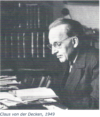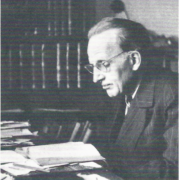Claus von der Decken
October 5, 1888, Preeten Castle – August 24, 1977, Kassel
 The midwife had to navigate the flooded Elbe meadows to get to Claus von der Decken’s birth on October 5, 1888, at Preeten Castle near Neuhaus. Claus was the second of four children who were joined by a foster sister. His father, Ernst, from the old Hanoverian landed gentry, was the administrator of various estates. His mother, Anna, was born von Arnswald, whose three sisters were abbesses of the noble convents of Bassum, Medingen, and Ebstorf. Anyone who was brought into a noble convent had to have sixteen full noble great-great-grandparents.
The midwife had to navigate the flooded Elbe meadows to get to Claus von der Decken’s birth on October 5, 1888, at Preeten Castle near Neuhaus. Claus was the second of four children who were joined by a foster sister. His father, Ernst, from the old Hanoverian landed gentry, was the administrator of various estates. His mother, Anna, was born von Arnswald, whose three sisters were abbesses of the noble convents of Bassum, Medingen, and Ebstorf. Anyone who was brought into a noble convent had to have sixteen full noble great-great-grandparents.
Claus von der Decken was what was then called a country gentleman. But his father, who was actually an artistic man, had an unfortunate hand in his property management. The property, which he had invested in large tenement houses in the early years, brought him losses instead of the profits he had hoped for. Nevertheless, his relatives let him continue to work and helped him.
The last small property his father still had was in Adendorf, not far from Lüneburg. From there, Claus and his two brothers went to school in Lüneburg for a while. At times they also had tutors; the young governesses of the three boys had a lot to put up with.
Claus completed his schooling (around 1904) and then took up voluntary military service with the Saxon Guard Riders in Dresden, which he finished as a lieutenant in 1908. He could then devote himself entirely to his artistic inclinations. He studied painting – especially portraiture – at the art academies in Düsseldorf, Dresden, Munich, and Paris. He also undertook an art trip to Rome during this time.
Claus wrote poetry throughout his life – sometimes up to fifty poems a year, but he also wrote dramas and more. When he studied in Düsseldorf, he was friends with the family of Lory Smits, who later became the first eurythmist. The elder Smits taught Rudolf Steiner a poem by Claus, which he praised. Tradition has it that Claus was sitting in the next room of the Smits house in 1909 when Rudolf Steiner gave the well-known lecture cycle on the angelic hierarchies in the salon. It is certain that Claus had not yet found access to anthroposophy at that time, although his very first encounter with Rudolf Steiner had probably taken place a year earlier.
While still a student, he was secretly engaged to Cécile von Bodenberg. The family of the nobles and freemen of Bodenberg belonged to the so-called dynastic nobility. They had their own vassals, owned land the size of a principality between the rivers Aller and Weser, and naturally belonged to the Guelph party and wanted to see the king reinstated in Hanover.
His father ordered the bride and groom to wait seven years before getting married. Naturally, Claus volunteered for military service in the First World War after finishing his studies. But when his two brothers soon died in the field, Claus was transferred to the rear echelon to spare him as the last scion of his family; then, his father allowed him to marry. The wedding took place on October 3, 1916, in Hudemühlen, ‘Estate Three.’ Back in the military, Claus was constantly commissioned to make portraits of comrades and superiors. He was stricken with typhoid. After the war, he painted some portraits of fallen members of parliament for the Reichstag building in Berlin, but they later fell victim to fire.
During the war, he encountered anthroposophy anew with great intensity. After the end of the war, it was Rudolf Meyer who pushed him hard: “You came through the war alive. You must make yourself available to Rudolf Steiner and the Threefold Movement!” Claus von der Decken did not listen to him.
From January 1918 onwards, the family grew by one child a year until there were seven to feed. They lived in an outlying estate of Hudemühlen, Hademstorf, a rural inn. Claus earned money by painting portraits, some of them quite “lucrative.” Being nobility and recommended in aristocratic circles, he painted on estates as far away as Silesia.
Once again, Rudolf Meyer approached him. It was in summer of 1921; the first steps towards religious renewal in the sense of anthroposophy had been taken. The June Course had taken place. Rudolf Meyer was looking for co-workers and met Claus von der Decken in a confectioner’s shop in Hanover to invite him to join the Autumn Course in Dornach and to help with the future work. Only then had the decision matured to commit himself – thirteen or fourteen years after his first acquaintance with anthroposophy and his first encounter with Rudolf Steiner. Although the family already had three children – a fourth died in the same year – and the economic prospects were very poor, Claus von der Decken decided to take up the priesthood.
On September 16, 1922, he was ordained as a priest by Emil Bock in Dornach. Together with Otto Becher, he founded the community in Hanover. The family could continue to live outside in Hudemühlen (today Hodenhagen/Aller). When money became too tight, the father moved out again, far across the country, to paint portraits.
Martin Schmidt, a rye breeder who later became widely known, had the means at that time, both through the superheated steam machine production in Kassel and through funds from America, to acquire his own farm in 1924, shortly before the Koberwitz course, which established biodynamic agriculture and in which he participated. He bought the Eschenhof in Grammersdorf on Hemmelsdorfer Sea, northeast of Lübeck. This soon became the home of the von der Decken family. From there, Claus von der Decken took over the community work in Lübeck that Joachim Sydow had started from Rostock.
 On the Eschenhof, the family had to endure difficult destinies, both humanly and in terms of health. Cécile von der Decken died in 1928, two years after the birth of her seventh child. Four years of family separation followed. The three older children moved with the Schmidt family to Kassel-Wilhelmshöhe to attend the Waldorf School. The three younger children stayed in Lübeck with their father and were looked after by his mother and sister.
On the Eschenhof, the family had to endure difficult destinies, both humanly and in terms of health. Cécile von der Decken died in 1928, two years after the birth of her seventh child. Four years of family separation followed. The three older children moved with the Schmidt family to Kassel-Wilhelmshöhe to attend the Waldorf School. The three younger children stayed in Lübeck with their father and were looked after by his mother and sister.
On October 5, 1931, Claus von der Decken took up church work in Kassel. In 1932 he entered into his second marriage. Melly von der Decken, née Hegewald, had taken on the difficult task of raising six children as a stepmother under oppressive hardships. Until one month before his death, she faithfully stood by her husband for over forty-five years.
Claus von der Decken worked as a priest in Kassel for over four decades. The ban on the Christian Community (from June 9, 1941) brought better economic times for the family. At last, there were sufficient funds for subsistence because Claus was painting portraits again. On the other hand, a second heavy blow of fate struck the the family when two sons fell in the war.

The priest’s unusual humanitarian commitment had already amazed those around him in Lübeck, where he spoke and prayed with alcoholics about the Blue Cross’s work against alcohol addiction. One of them later had himself married by him. In Kassel, he helped Jewish people to escape during the Nazi era. During the heavy bombing raids, he visited the rubble sites, once rescuing a woman from the flames and giving her shelter with his own family.
He was distinguished by a particularly rich, strong emotional capacity. Unforgettable was his humor that expressed itself so quaintly when he told stories in the Low German dialect. He was an artist and a priest. His poems were published in the magazine The Christengemeinschaft. Of his dramas, Pontius Pilatus was published in 1963. Claus von der Decken experienced a special, humanitarian and amicable fulfillment of his work on the occasion of a series of community camps, which he organized with Wolf-Dietrich von Kurnatowski, Friedrich Gädeke, and other colleagues in the 1950s and 1960s on the Sonnenberg in the Upper Harz, north of St. Andreasberg.

As a poet and painter, he was tirelessly active. His most important works for the priests’ circle are probably the two fine death portraits of Friedrich Rittelmeyer and Emil Bock. But he had been committed to working for a new priesthood ever since he asked Rudolf Steiner: “Can the priesthood be conducive with my artistry?” and the latter had replied: “Yes, your artistry can be conducive to your priesthood.” Many destinies in the priest circle would have been better mastered if this sentence had been taken to heart.
On August 24, 1977, Claus von der Decken died in Kassel a few weeks before his 89th birthday.



Leave a Reply
Want to join the discussion?Feel free to contribute!